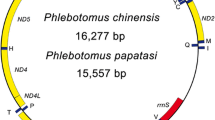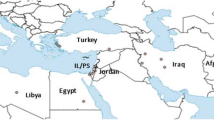Abstract
Next-generation sequencing (NGS) was used to investigate the genetic diversity of Leishmania tropica in the sand fly vector, targeting the internal transcribed spacer 1 (ITS1) of the genus Leishmania. Bioinformatics analyses were conducted using Galaxy, MEGA version X, DnaSP ver. 6.12.03, and PopART 1.7 software for NGS analysis, phylogenetic tree, genetic diversity, and haplotype networking, respectively. A total of 307 engorged sand flies were trapped, with an overall Leishmania infection rate of 9.4 (29/307) and 6.8% by NGS and ITS1-PCR, respectively. Two Leishmania-infected sand fly genera were identified: Phlebotomus (10.2%, 26/254) and Sergentomyia (5.7% (3/53). The phylogenetic tree showed two clusters, cluster I included the four study sequences along with 25 GenBank-retrieved DNA sequences. Cluster II consisted of three sequences from Iran and Pakistan. The genetic diversity analysis for the 29 L. tropica sequences showed high haplotype (gene) diversity index (Hd) (0.62 ± 0.07) but low nucleotide diversity index (π) (0.04 ± 0.01). Tajima’s D, a neutrality test, is more negative in cluster I (D = − 2.0) than in total population (D = − 1.83), but both are equally significant (P < 0.001), indicating that observed variation in cluster I and whole population is less frequent than expected. The median-joining haplotype network produced a total of 11 active haplotypes. In conclusion, L. tropica from sand flies in Palestine is monophyletic that assembled in one main phylogroup and one haplotype.


Similar content being viewed by others
Data availability
All data are available in the manuscript, including the accession numbers of 22 DNA sequences that have been deposited in the NCBI GenBank. However, the datasets analyzed during the current study are available from the corresponding author upon reasonable request.
References
Akhoundi M et al (2016) A historical overview of the classification, evolution, and dispersion of Leishmania parasites and sandflies. PLoS Negl Trop Dis 10(3):e0004349. https://doi.org/10.1371/journal.pntd.0004349
Al-Jawabreh A et al (2008) Identification of geographically distributed sub-populations of Leishmania (Leishmania) major by microsatellite analysis. BMC Evol Biol 8:183. https://doi.org/10.1186/1471-2148-8-183
Al-Jawabreh A et al (2017) Molecular epidemiology of human cutaneous leishmaniasis in Jericho and its vicinity in Palestine from 1994 to 2015. Infect Genet Evol 50:95–101. https://doi.org/10.1016/j.meegid.2016.06.007
Al-Jawabreh A et al (2004) The recent emergence of Leishmania tropica in Jericho (A'riha) and its environs, a classical focus of L. major. Trop Med Int Health 9(7):812–816. https://doi.org/10.1111/j.1365-3156.2004.01268.x
Al-Jawabreh A, Schoenian G, Hamarsheh O, Presber W (2006) Clinical diagnosis of cutaneous leishmaniasis: a comparison study between standardized graded direct microscopy and ITS1-PCR of Giemsa-stained smears. Acta Trop 99(1):55–61. https://doi.org/10.1016/j.actatropica.2006.07.001
Alam MZ et al (2009) Multilocus microsatellite typing (MLMT) reveals genetic homogeneity of Leishmania donovani strains in the Indian subcontinent. Infect Genet Evol 9(1):24–31. https://doi.org/10.1016/j.meegid.2008.09.005
Alexander B (2000) Sampling methods for phlebotomine sandflies. Med Vet Entomol 14(2):109–122. https://doi.org/10.1046/j.1365-2915.2000.00237.x
Alvar J et al (2012) Leishmaniasis worldwide and global estimates of its incidence. PloS One 7(5):e35671. https://doi.org/10.1371/journal.pone.0035671
Azmi K et al (2017) Increased prevalence of human cutaneous leishmaniasis in Israel and the Palestinian Authority caused by the recent emergence of a population of genetically similar strains of Leishmania tropica. Infect Genet Evol 50:102–109. https://doi.org/10.1016/j.meegid.2016.07.035
Bandelt HJ, Forster P, Rohl A (1999) Median-joining networks for inferring intraspecific phylogenies. Mol Biol Evol 16(1):37–48. https://doi.org/10.1093/oxfordjournals.molbev.a026036
Caligiuri LG et al (2019) Optimization of DNA Extraction from individual sand flies for PCR amplification. Methods Protoc 2(2). https://doi.org/10.3390/mps2020036
Carvalho KSS et al (2020) Application of next generation sequencing (NGS) for descriptive analysis of 30 genomes of Leishmania infantum isolates in Middle-North Brazil. Sci Rep 10(1):12321. https://doi.org/10.1038/s41598-020-68953-9
Casaril AE et al (2017) Standardization of DNA extraction from sand flies: application to genotyping by next generation sequencing. Exp Parasitol 177:66–72. https://doi.org/10.1016/j.exppara.2017.04.010
Chen H et al (2020) leishmaniasis diagnosis via metagenomic next-generation sequencing. Front Cell Infect Microbiol 10:528884. https://doi.org/10.3389/fcimb.2020.528884
Dedet JP (2005) Stages in the identification of phlebotomine sandflies as vectors of Leishmaniases and other tropical diseases. Parassitologia 47(3-4):291–295
El Hamouchi A, Ajaoud M, Arroub H, Charrel R, Lemrani M (2019) Genetic diversity of Leishmania tropica in Morocco: does the dominance of one haplotype signify its fitness in both predominantly anthropophilic Phlebotomus sergenti and human beings? Transbound Emerg Dis 66(1):373–380. https://doi.org/10.1111/tbed.13031
Fakhar M et al (2016) Genetic diversity of Leishmania tropica strains isolated from clinical forms of cutaneous leishmaniasis in rural districts of Herat province, Western Afghanistan, based on ITS1-rDNA. Infect Genet Evol 41:120–127. https://doi.org/10.1016/j.meegid.2016.03.031
Ghatee MA, Mirhendi H, Marashifard M, Kanannejad Z, Taylor WR, Sharifi I (2018) Population structure of leishmania tropica causing anthroponotic cutaneous leishmaniasis in Southern Iran by PCR-RFLP of kinetoplastid DNA. Biomed Res Int 2018:6049198. https://doi.org/10.1155/2018/6049198
Giantsis IA, Chaskopoulou A, Claude Bon M (2017) Direct multiplex PCR (dmPCR) for the Identification of six phlebotomine sand fly species (Diptera: Psychodidae), including major Leishmania vectors of the Mediterranean. J Econ Entomol 110(1):245–249. https://doi.org/10.1093/jee/tow269
Hudson RR, Slatkin M, Maddison WP (1992) Estimation of levels of gene flow from DNA sequence data. Genetics 132(2):583–589
Jacobson RL, et al. (2003) Outbreak of cutaneous leishmaniasis in northern Israel. J Infect Dis 188(7):1065-1073. https://doi.org/10.1086/378204
Kamhawi S (2006) Phlebotomine sand flies and Leishmania parasites: friends or foes? Trends Parasitol 22(9):439–445. https://doi.org/10.1016/j.pt.2006.06.012
Killick-Kendrick R (1987) Methods for the study of phlebotomine sandflies. In: Peters W, Killick-Kendrick R (eds) The leishmaniases in biology and medicine. Academic Press, London, pp 473–497
Killick-Kendrick R (1990) Phlebotomine vectors of the Leishmaniases: a review. Med Vet Entomol 4(1):1–24. https://doi.org/10.1111/j.1365-2915.1990.tb00255.x
Kounosu A, Murase K, Yoshida A, Maruyama H, Kikuchi T (2019) Improved 18S and 28S rDNA primer sets for NGS-based parasite detection. Sci Rep 9(1):15789. https://doi.org/10.1038/s41598-019-52422-z
Krayter L et al (2014) Multilocus microsatellite typing reveals a genetic relationship but, also, genetic differences between Indian strains of Leishmania tropica causing cutaneous leishmaniasis and those causing visceral leishmaniasis. Parasit Vectors 7:123. https://doi.org/10.1186/1756-3305-7-123
Kreutzer RD, Christensen HA (1980) Characterization of Leishmania spp. by isozyme electrophoresis. Am J Trop Med Hyg 29(2):199–208. https://doi.org/10.4269/ajtmh.1980.29.199
Kuhls K et al (2011) Comparative microsatellite typing of new world leishmania infantum reveals low heterogeneity among populations and its recent old world origin. PLoS Negl Trop Dis 5(6):e1155. https://doi.org/10.1371/journal.pntd.0001155
Kumar S, Stecher G, Li M, Knyaz C, Tamura K (2018) MEGA X: molecular evolutionary genetics analysis across computing platforms. Mol Biol Evol 35(6):1547–1549. https://doi.org/10.1093/molbev/msy096
Lane RP (1986) The sand flies of Egypt (Diptera: Phlebotominae). Bull Br Mus Nat Hist Entomol 52:1–35
Lewis D, Buttiker W (1982) Insects of Saudi Arabia: the taxonomy and distribution of Saudi Arabian Phlebotomus sandflies (Diptera: Psychodidae). Fauna of Saudi Arabia 4:353–383
Lewis DJ (1982) A taxonomic review of the genus Phlebotomus (Diptera: Psychodidae). Bulletin of the British museum (natural history) Entomology series 45:121–209
Mhaidi I et al (2018) Molecular identification of Leishmania infection in the most relevant sand fly species and in patient skin samples from a cutaneous leishmaniasis focus, in Morocco. PLoS Negl Trop Dis 12(3):e0006315. https://doi.org/10.1371/journal.pntd.0006315
Nasereddin A et al (2022) Concurrent molecular characterization of sand flies and Leishmania parasites by amplicon-based next-generation sequencing. Parasit Vectors 15(1):262. https://doi.org/10.1186/s13071-022-05388-3
Nei M (1973) Analysis of gene diversity in subdivided populations. Proc Natl Acad Sci U S A 70(12):3321–3323. https://doi.org/10.1073/pnas.70.12.3321
Nei M (1987) Molecular evolutionary genetics. Columbia University Press, New York
Palestinian-Central-Bureau-of-Statistics (2020) Projected mid -year population for Tubas & Northern Governorate by Locality 2017-2021. http://www.pcbs.gov.ps/Portals/_Rainbow/Documents/TubasE.html
Perffl’ev PP (1966) Sandflies (family Phlebotomidae) [In Russian] fauna of the USSR new series, 93. vol 3 (2). Academy of sciences, Moscow, p 382
Rioux JA, Lanotte G, Maazoun R, Perello R, Pratlong F (1980) Leishmania infantum Nicolle, 1908, the agent of the autochthonous oriental sore. Apropos of the biochemical identification of 2 strains isolated in the eastern Pyrenees. C R Seances Acad Sci D 291(8):701–703
Rivas MA et al (2011) Deep resequencing of GWAS loci identifies independent rare variants associated with inflammatory bowel disease. Nat Genet 43(11):1066–1073. https://doi.org/10.1038/ng.952
Rozas J et al (2017) DnaSP 6: DNA sequence polymorphism analysis of large data sets. Mol Biol Evol 34(12):3299–3302. https://doi.org/10.1093/molbev/msx248
Sawalha S et al (2022) Effectiveness of insecticide thermal fogging in hyrax dens in the control of leishmaniasis vectors in rural Palestine: a prospective study. PLoS Negl Trop Dis 16(9):e0010628. https://doi.org/10.1371/journal.pntd.0010628
Sawalha SS, Ramlawi A, Sansur RM, Salem IM, Amr ZS (2017) Diversity, ecology, and seasonality of sand flies (Diptera: Psychodidae) of the Jenin District (Palestinian Territories). J Vector Ecol 42(1):120–129. https://doi.org/10.1111/jvec.12246
Sawalha SS, Shtayeh MS, Khanfar HM, Warburg A, Abdeen ZA (2003) Phlebotomine sand flies (Diptera: Psychodidae) of the Palestinian West Bank: potential vectors of leishmaniasis. J Med Entomol 40(3):321–328. https://doi.org/10.1603/0022-2585-40.3.321
Schnur LF, Zuckerman A, Greenblatt CL (1972) Leishmanial serotypes as distinguished by the gel diffusion of factors excreted in vitro and in vivo. Isr J Med Sci 8:932–942
Schonian G et al (2003) PCR diagnosis and characterization of Leishmania in local and imported clinical samples. Diagn Microbiol Infect Dis 47(1):349–358. https://doi.org/10.1016/s0732-8893(03)00093-2
Schonian G et al (2001) Genetic heterogeneity in the species Leishmania tropica revealed by different PCR-based methods. Trans R Soc Trop Med Hyg 95(2):217–224. https://doi.org/10.1016/s0035-9203(01)90173-7
Schuster SC (2008) Next-generation sequencing transforms today's biology. Nat Methods 5(1):16–18. https://doi.org/10.1038/nmeth1156
Schwenkenbecher JM, Frohlich C, Gehre F, Schnur LF, Schonian G (2004) Evolution and conservation of microsatellite markers for Leishmania tropica. Infect Genet Evol 4(2):99–105. https://doi.org/10.1016/j.meegid.2004.01.005
Schwenkenbecher JM et al (2006) Microsatellite analysis reveals genetic structure of Leishmania tropica. Int J Parasitol 36(2):237–246. https://doi.org/10.1016/j.ijpara.2005.09.010
Shendure J, Ji H (2008) Next-generation DNA sequencing. Nat Biotechnol 26(10):1135–1145. https://doi.org/10.1038/nbt1486
Shortt HE, Swaminath CS (1928) The method of feeding of Phlebotomus argipentes with relation to its bearing on the transmission of kala-azar. Indian J Med Res 15:827–836
Srivastava P, Singh T, Sundar S (2011) Genetic heterogeneity in clinical isolates of Leishmania donovani from India. J Clin Microbiol 49(10):3687–3690. https://doi.org/10.1128/JCM.00729-11
Svobodova M et al (2006) Distinct transmission cycles of Leishmania tropica in 2 adjacent foci, northern Israel. Emerg Infect Dis 12(12):1860–1868. https://doi.org/10.3201/eid1212.060497
Tajima F (1983) Evolutionary relationship of DNA sequences in finite populations. Genetics 105(2):437–460
Tamura K, Nei M (1993) Estimation of the number of nucleotide substitutions in the control region of mitochondrial DNA in humans and chimpanzees. Mol Biol Evol 10(3):512–526. https://doi.org/10.1093/oxfordjournals.molbev.a040023
Wright S (1951) The genetical structure of populations. Ann Eugen 15(4):323–354. https://doi.org/10.1111/j.1469-1809.1949.tb02451.x
Funding
This work was supported by USAID (M33-07).
Author information
Authors and Affiliations
Contributions
Conceptualization, A. J, S.E, and A.N; methodology, S. E, A.N, K. D, and H.J; software, A. N, and A.J; validation, S. E, K.D, and H.J; formal analysis, A. N, S.E, K. D, and AJ; investigation, S. E, A.J, and K.D; resources, H.J; data curation, S. E and AN; writing—original draft preparation, S.E; writing—review and editing, A. J and A.N; visualization, K.D; supervision, A.N; project administration, A.J; funding acquisition, A.J.
Corresponding author
Ethics declarations
Ethics approval and consent to participate
Not applicable.
Consent for publication
The authors declare that they are aware of the publication of this study.
Competing interest
The authors declare no competing interests.
Additional information
Section Editor: Dorien Mabille
Publisher’s note
Springer Nature remains neutral with regard to jurisdictional claims in published maps and institutional affiliations.
Rights and permissions
Springer Nature or its licensor (e.g. a society or other partner) holds exclusive rights to this article under a publishing agreement with the author(s) or other rightsholder(s); author self-archiving of the accepted manuscript version of this article is solely governed by the terms of such publishing agreement and applicable law.
About this article
Cite this article
Al-Jawabreh, A., Ereqat, S., Al-Jawabreh, H. et al. Genetic diversity and haplotype analysis of Leishmania tropica identified in sand fly vectors of the genera Phlebotomus and Sergentomyia using next-generation sequencing technology. Parasitol Res 122, 1351–1360 (2023). https://doi.org/10.1007/s00436-023-07835-1
Received:
Accepted:
Published:
Issue Date:
DOI: https://doi.org/10.1007/s00436-023-07835-1




